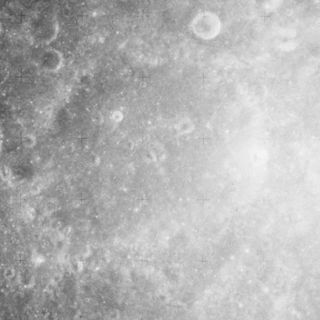
Doppler is a lunar impact crater named for Christian Doppler that is located at the southern edge of the walled plain Korolev, on the far side of the Moon. To the east are the craters Das and Galois. Farther to the southwest of Doppler is Mohorovičić.

Arrhenius is a lunar impact crater that is located just on the far side of the Moon, near the southwest limb. In this location the vicinity of the crater can be viewed during favorable librations, although it is viewed from on edge. To the south-southeast is the worn crater Blanchard, and De Roy lies further to the west.

Boss is a lunar impact crater that is located along the northeast rim of the Moon's near side. Due to its location, the crater is viewed from the side by observers on the Earth, and its visibility is subject to libration effects.

Byrd is an irregular lunar impact crater that is located near the north pole of the Moon. The north rim of Byrd is nearly connected to the crater Peary, a formation that is adjacent to the pole. The smaller crater Gioja is attached to the remains of the southwest rim.

Baco is a lunar impact crater that lies in the rugged southern highlands on the near side of the Moon. The rim and inner wall has been eroded and worn by countless minor impacts since the original formation of the crater. As a result, any terraces have been worn smooth and the rim is overlaid by several tiny craterlets. The interior floor is nearly flat, with no characteristic central peak at the midpoint and no small craters of significance.

Blanchinus is a lunar impact crater that is situated in the rugged south-central highlands of the Moon. The crater is named after Italian astronomer Giovanni Bianchini whose Latinized name is Blanchinus. Adjacent to the south of Blanchinus is the crater Werner, and La Caille is attached to the northwest rim. West of the crater is the prominent formation Purbach.

Boyle is a lunar impact crater that is located in the southern hemisphere on the rugged far side of the Moon. It is adjacent to the larger crater Hess to the southeast, and lies about midway between the craters Alder to the north-northeast and Abbe to the south-southwest.

Cepheus is a lunar impact crater that is located in the northeastern part of the Moon, within one crater diameter of the larger crater Franklin to the southeast. To the north-north-east is the flooded crater Oersted. The proximity of this formation to the lunar limb means it appears oblong when viewed from the Earth due to foreshortening.

Barringer is a lunar impact crater that is located on the southern hemisphere on the far side of the Moon. It is attached to the north-northeastern rim of the walled basin named Apollo, and lies to the southeast of Plummer. South of Barringer, on the floor of the Apollo basin, is the crater Scobee.

Buisson is a lunar impact crater that is located on the far side of the Moon. It is named after the French physicist Henri Buisson. Nearly attached to the southeast rim is the crater Vesalius. To the southwest is Einthoven. The rim of this crater is somewhat worn, and is lowest in the north. There is a low central ridge across the midpoint.

Casatus is a lunar impact crater that is located near the southern limb of the Moon. The north-northeast rim of the crater overlies a portion of the slightly larger crater Klaproth. Along the western rim, Casatus A intrudes somewhat into the interior, producing an inward-bowing rim. To the southeast of Casatus is Newton.

Demonax is a lunar impact crater near the southern limb of the Moon. This location makes the crater difficult to observe due to foreshortening. The crater is also illuminated at a very low angle, when it is in the sunlit side. Demonax lies just to the north of the crater Scott, one of the south polar formations. To the north-northwest is Boguslawsky.

Carver is a lunar impact crater that is located on the far side of the Moon, due east of the walled plain Van der Waals. To the northeast is the crater Rosseland, and to the south-southeast lies Kozyrev.

Chappell is a lunar impact crater that is located on the far side of the Moon, in the northern hemisphere just to the north of the crater Debye. This feature is located in a heavily bombarded section of the surface, and much of the outer rim of the crater is overlain by many smaller craters. The northern rim in particular has been almost completely disintegrated, while small craters also overlie the rim to the northwest and southeast. What remains of the rim forms a rounded, somewhat irregular edge to the crater depression.

Charlier is a lunar impact crater that is located on the far side of the Moon. To the south-southeast is the larger crater Kovalevskaya, and northeast of Charlier is Perrine.

Chandler is a lunar impact crater in the northern hemisphere, on the Moon's far side. It lies to the southeast of the large walled plain D'Alembert, and southeast of the slightly smaller Chernyshev crater.

Douglass is a lunar impact crater on the far side of the Moon. It lies to the southwest of the crater Frost and south-southwest of the large walled plain Landau.

Dreyer is the remnant of a lunar impact crater on the far side of the Moon. It is located along the eastern edge of the Mare Marginis, about midway between the craters Ginzel to the north and Erro to the south-southeast. It was named after Danish-Irish astronomer John L. E. Dreyer.

Mechnikov is an impact crater on the far side of the Moon. It is located just to the northeast of the much larger walled plain Galois, being separated by a stretch of irregular terrain about 20–30 km in width.

























